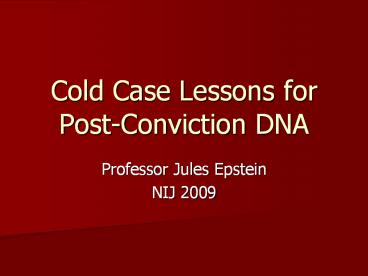Cold Case Lessons for Post-Conviction DNA - PowerPoint PPT Presentation
Title:
Cold Case Lessons for Post-Conviction DNA
Description:
... one switched their identification to person 'B' when told that 'B' had confessed. ... DNA testing because defendant 'confessed' and did not challenge ... – PowerPoint PPT presentation
Number of Views:220
Avg rating:3.0/5.0
Title: Cold Case Lessons for Post-Conviction DNA
1
Cold Case Lessons for Post-Conviction DNA
- Professor Jules Epstein
- NIJ 2009
2
(No Transcript)
3
Lesson I Corroborative Evidence Isnt The Test
- Exonerations have
- Confessions
- Forensics
- Eyewitnesses
- Informants
4
Lesson I Decisional Law
- Just because the prosecution's evidence, if
credited, would provide strong support for a
guilty verdict, it does not follow that evidence
of third-party guilt has only a weak logical
connection to the central issues in the case. - Holmes (trial standard)
5
Lesson I Decisional Law
- The strength of the evidence against a
defendant is not a relevant factor in determining
whether his identity as the perpetrator was a
significant issue. State v. Peterson, 836 A.2d
821, 827 (App.Div. 2003)
6
Lesson I Decisional Law
- The strength of the State's case was not a
hurdle that he had to overcome in order to meet
the statute's requirements for postconviction
forensic testing. Illinois.
7
Lesson I Science
- In a recent staged crime study, witnesses who
viewed a lineup and picked person A or no one
switched their identification to person B when
told that B had confessed.
8
Lesson I Investigation Errors
9
Lesson I Investigation Errors
- Tunnel Vision has afflicted both
prosecution/police and defense investigations. - THE MULTIPLE DIMENSIONS OF TUNNEL VISION IN
CRIMINAL CASES, 2006 Wis. L. Rev. 291 ,
10
Keep Investigating
- In 12 DNA exoneration cases, defendants were
convicted when DNA evidence at trial made clear
it was not the accused. - The facts fit some theory.
11
Keep Investigating
- In the 12 cases, when the crime scene DNA was run
against the database or against a new suspect,
the real more likely? perpetrator was found.
12
Lesson II ConstitutionalityIsnt The Test
13
Concerns Regarding Suppression Law - I
- Of the first 200 DNA exonerations, 158 involved
eyewitness testimony - 29 raised suggestive ID claims
- None received relief
14
Concerns RegardingSuppression Law - II
- Of the first 200 DNA exonerations, 20 involved
confessions - 10 cases challenged constitutionality
- 13 cases challenged some aspect of confession
- None prevailed
15
Lesson III Criminal PastIsnt The Test
16
Exonerees Had a Past
- In 80 of the DNA exoneration cases, more than
half of the exonerees had prior convictions.
17
The Disconnect
- No DNA testing because defendant confessed and
did not challenge confession as
unconstitutionally obtained. Pennsylvania.
18
The Disconnect
- If the allegation of the petitioner's innocence
is recent and the evidence supports the
petitioner as the offender, a prior confession
may be enough to deny DNA testing. Tennessee
19
Disconnect
- It is inconsistent to allow defendants who
pleaded guilty to use post-conviction
proceedingsin light of alleged new evidence
20
Disconnect
- Both his confession and his new claims cannot be
true. A defendant knows at the time of his plea
whether he is guiltyand with the guilty plea
waives the right to present evidence regarding
guilt or innocence. Indiana, 2008 (not a DNA
case).
21
Disconnect
- November, 2008
- Washington State trial court denies
post-conviction testing because the blood-spatter
evidence was convincing and overwhelming.
22
Disconnect
- Nine exonerees pleaded guilty and many more did
not dispute identity at trial
23
So, Whats A Reasonable Test?
- Ignore other evidence ask about the potential of
the DNA? - Remember the decision to agree to test is not
the same as the decision of what to do with test
results.
24
Whats Reasonable
- Consider the converse DNA is sufficient to
convict, even with bad description and no ID.
People v. Soto, 981 P.2d 958 (Cal. 1999) - Is this innocence or PBRD?
25
Collateral Lessons - I
- Familial DNA and Darryl Hunt
- If its good enough for exonerations, isnt it
good enough for investigations? - Is this a database expansion issue?
26
Collateral Lessons - II
- Statutes of Limitations for Prosecutions
- Eliminate
- Expand
- Toll (John Doe)
- Defense Due Process (loss of witnesses)
- Statutes of Limitations for Post-Conviction DNA
- Strict (5 states have a 1-3 year post-conviction
limit) - Prosecution Loss of witnesses?
27
Collateral Issues - III
- Defense Access to CODIS
- Jeffrey Deskovic (database checked 16 years
later) - Query Is this a right under Brady v. Maryland?
Is the federal database part of the local/state
prosecutorial team? Kyles v. Whitley. - 2 states allow post-conviction access to NDIS
28
Collateral Issues - IV
- Should we have statutes for other types of
post-conviction testing? - Six states and Washington, D.C. do.
29
Reliability, Not Adversariness
- Findley, TOWARD A NEW PARADIGM OF CRIMINAL
JUSTICE HOW THE INNOCENCE MOVEMENT MERGES CRIME
CONTROL AND DUE PROCESS, University of Wisconsin
Law School 2009
30
References
- THE MULTIPLE DIMENSIONS OF TUNNEL VISION IN
CRIMINAL CASES, 2006 Wis. L. Rev. 291 - John Blume, The Dilemma of the Criminal Defendant
With a Prior Record - Lessons from the Wrongfully
Convicted (2008) - Brandon Garrett, Claiming Innocence, 92 Minn. L.
Rev. 1629 (June, 2008)
31
References
- Brandon L. Garrett, Judging Innocence, 108 Colum.
L. Rev. 55 (2008) - Risinger, INNOCENTS CONVICTED AN EMPIRICALLY
JUSTIFIED FACTUAL WRONGFUL CONVICTION RATE, 97 J.
Crim. L. Criminology 761 (Spring, 2007)
32
References
- Epstein, Genetic Surveillance - The Bogeyman
Response to Familial DNA Investigations
(forthcoming, Journal of Law, Technology and
Policy) - Samuel Gross, Convicting the Innocent, Annu. Rev.
Law Soc. Sci. 2008. 417392.
33
References
- House v. Bell, 126 S. Ct. 2064 (U.S. 2006)
- United States v. Risha, 445 F.3d 298 (3rd Cir.
2006)































